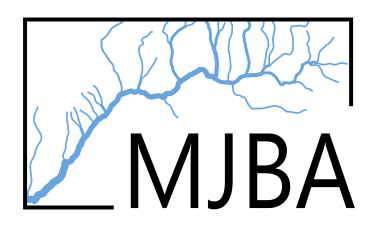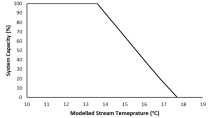Summer Temperature and Westslope Cutthroat Trout
mbakken
View all records in the stressor response library
Species Common Name
Westslope Cutthroat Trout
Latin Name (Genus species)
Oncorhynchus mykiss lewisi
Stressor Name
Summer temperature
Specific Stressor Metric
Modelled stream temperature
Stressor Units
°C
Vital Rate (Process)
System capacity
Geography
Alberta foothills watersheds, excluding National Parks
Detailed SR Function Description
Each of the three native trout species are thermally sensitive and vulnerable to increased water temperature resulting from land disturbance and climate change (GOA 2023; Alberta Athabasca Rainbow Trout Recovery Team 2014; The Westslope Cutthroat Trout Recovery Team 2013).
Westslope Cutthroat Trout is a thermally sensitive cold-water salmonid vulnerable to increased water temperatures resulting from land disturbance and climate change (ASRD and ACA 2006). The thermal characteristics of Westslope Cutthroat Trout habitat in Alberta were explored by comparing modelled mean summer stream temperatures to all locations where cutthroat trout have been captured between 1946-2016 (FWMIS query, April 2017). In addition, we also compared stream temperatures across Westslope Cutthroat range. The stream temperature model used was created using a step-wise multiple linear regression model. This incorporated mean summer (August and September) air temperature and land use co-variates found in ALCES Online© to create a basin specific (Oldman River or Bow River) model (MacDonald and Jones 2017). The mean water temperature thresholds (8-18°C) were similar to those reported in previous laboratory and field studies investigating the effects of water temperature on Westslope Cutthroat Trout hybridization (e.g. Muhlfeld et al. 2009) and growth and survival (e.g. Bear et al. 2007). The findings of this analysis were used to inform the shape of the dose-response curve below, which characterizes the expected influence of warm temperature on the sustainability of Westslope Cutthroat Trout populations (Figure 1).
The rapid decline in the number of occurrences of the three trout species on the colder ranges, between 10°C to 13°C for Bull Trout, 6°C to 8°C for Athabasca Rainbow Trout and 8°C to 13°C for Westslope Cutthroat Trout is likely due to sampling bias (i.e., there are fewer sampling events in cold, high-elevation areas that are difficult to access). However, in visually inspecting stream temperatures in colonized Jasper National Park streams with excellent Athabasca Rainbow Trout populations they fall within the modelled 5-8°C temperature range. Therefore, lotic habitats with these colder temperatures were still considered to be excellent Athabasca Rainbow Trout habitat and while cold temperatures undoubtedly can limit Bull Trout and Westslope Cutthroat Trout distributions, for the first iteration of this dose-response curve the results were not extended to the cold side of the curve due to lower confidence in this portion of the analysis.
Westslope Cutthroat Trout is a thermally sensitive cold-water salmonid vulnerable to increased water temperatures resulting from land disturbance and climate change (ASRD and ACA 2006). The thermal characteristics of Westslope Cutthroat Trout habitat in Alberta were explored by comparing modelled mean summer stream temperatures to all locations where cutthroat trout have been captured between 1946-2016 (FWMIS query, April 2017). In addition, we also compared stream temperatures across Westslope Cutthroat range. The stream temperature model used was created using a step-wise multiple linear regression model. This incorporated mean summer (August and September) air temperature and land use co-variates found in ALCES Online© to create a basin specific (Oldman River or Bow River) model (MacDonald and Jones 2017). The mean water temperature thresholds (8-18°C) were similar to those reported in previous laboratory and field studies investigating the effects of water temperature on Westslope Cutthroat Trout hybridization (e.g. Muhlfeld et al. 2009) and growth and survival (e.g. Bear et al. 2007). The findings of this analysis were used to inform the shape of the dose-response curve below, which characterizes the expected influence of warm temperature on the sustainability of Westslope Cutthroat Trout populations (Figure 1).
The rapid decline in the number of occurrences of the three trout species on the colder ranges, between 10°C to 13°C for Bull Trout, 6°C to 8°C for Athabasca Rainbow Trout and 8°C to 13°C for Westslope Cutthroat Trout is likely due to sampling bias (i.e., there are fewer sampling events in cold, high-elevation areas that are difficult to access). However, in visually inspecting stream temperatures in colonized Jasper National Park streams with excellent Athabasca Rainbow Trout populations they fall within the modelled 5-8°C temperature range. Therefore, lotic habitats with these colder temperatures were still considered to be excellent Athabasca Rainbow Trout habitat and while cold temperatures undoubtedly can limit Bull Trout and Westslope Cutthroat Trout distributions, for the first iteration of this dose-response curve the results were not extended to the cold side of the curve due to lower confidence in this portion of the analysis.
Function Derivation
Empirical data; Landscape correlation; Published (peer-reviewed)
Transferability of Function
This function was developed and applied to Westslope Cutthroat Trout in Alberta foothills watersheds. The data comes from landscape correlation with Alberta Westslope Cutthroat streams and is supported by values in the published literature of this species in other regions. It could be applied to other populations of Westslope Cutthroat Trout with caution.
Source of stressor Data
Athabasca Rainbow Trout and Westslope Cutthroat Trout inputs were derived from modelled mean summer stream temperature (°C) provided by ALCES Online© within the spatial unit of interest (e.g., HUC 10 watershed).
Function Type
continuous
Stressor Scale
linear
References Cited
Government of Alberta. 2024. Temperature stressor-response function for Westslope Cutthroat Trout. Environment and Protected Area Native Trout Cumulative Effects Model.
AARTRT - Alberta Athabasca Rainbow Trout Recovery Team. 2014. Alberta Athabasca Rainbow Trout Recovery Plan, 2014-2019. Alberta Environment and Sustainable Resources Development, Alberta Species at Risk Recovery Plan No. 36. Edmonton, AB. 111 pp.
ASRD & ACA - Alberta Sustainable Resource Development and Alberta Conservation Association. 2006. Status of the Westslope Cutthroat Trout (Oncorhynchus clarkii lewisii) in Alberta. Alberta Sustainable Resource Development, Wildlife Status Report No. 61, Edmonton, AB. 34 pp.
AWCTRT - Alberta Westslope Cutthroat Trout Recovery Team. 2013. Alberta Westslope Cutthroat Trout Recovery Plan: 2012-2017. Alberta Environment and Sustainable Resources Development, Alberta Species at Risk Recovery Plan No. 28. Edmonton, AB. 77 pp.
Bear, E.A., T.E. McMahon, and A.V. Zale. 2007. Comparative thermal requirements of westslope cutthroat trout and rainbow trout: Implications for species interactions and development of thermal protection standards. Transactions of the American Fisheries Society 136: 1113-1121.
Government of Alberta (GOA). 2023. Alberta Bull Trout Recovery Plan. Alberta Species at Risk Recovery Plan No. 46. Edmonton, AB. 64 pp.
MacDonald, R.J., and Jones, L. 2017. Stream temperature modelling for Alberta using ALCES Online. ALCES Landscape and Landuse Ltd. 4 pp.
Muhlfeld, C.C., T.E. McMahon, M.C. Boyer, R.E. Gresswell. 2009. Local habitat, watershed, and biotic factors influencing the spread of hybridization between native Westslope Cutthroat Trout and introduced Rainbow Trout. Transactions of the American Fisheries Society 138:1036-1051.
AARTRT - Alberta Athabasca Rainbow Trout Recovery Team. 2014. Alberta Athabasca Rainbow Trout Recovery Plan, 2014-2019. Alberta Environment and Sustainable Resources Development, Alberta Species at Risk Recovery Plan No. 36. Edmonton, AB. 111 pp.
ASRD & ACA - Alberta Sustainable Resource Development and Alberta Conservation Association. 2006. Status of the Westslope Cutthroat Trout (Oncorhynchus clarkii lewisii) in Alberta. Alberta Sustainable Resource Development, Wildlife Status Report No. 61, Edmonton, AB. 34 pp.
AWCTRT - Alberta Westslope Cutthroat Trout Recovery Team. 2013. Alberta Westslope Cutthroat Trout Recovery Plan: 2012-2017. Alberta Environment and Sustainable Resources Development, Alberta Species at Risk Recovery Plan No. 28. Edmonton, AB. 77 pp.
Bear, E.A., T.E. McMahon, and A.V. Zale. 2007. Comparative thermal requirements of westslope cutthroat trout and rainbow trout: Implications for species interactions and development of thermal protection standards. Transactions of the American Fisheries Society 136: 1113-1121.
Government of Alberta (GOA). 2023. Alberta Bull Trout Recovery Plan. Alberta Species at Risk Recovery Plan No. 46. Edmonton, AB. 64 pp.
MacDonald, R.J., and Jones, L. 2017. Stream temperature modelling for Alberta using ALCES Online. ALCES Landscape and Landuse Ltd. 4 pp.
Muhlfeld, C.C., T.E. McMahon, M.C. Boyer, R.E. Gresswell. 2009. Local habitat, watershed, and biotic factors influencing the spread of hybridization between native Westslope Cutthroat Trout and introduced Rainbow Trout. Transactions of the American Fisheries Society 138:1036-1051.
File Upload
Stressor Response csv data
Data_WSCT_summerTemp.csv
(227 bytes)
| Temperature (oC) | Mean System Capacity (%) | SD | low.limit | up.limit |
|---|---|---|---|---|
| 10 | 100 | 0 | 0 | 100 |
| 11 | 100 | 0 | 0 | 100 |
| 12 | 100 | 0 | 0 | 100 |
| 13 | 100 | 0 | 0 | 100 |
| 13.6 | 100 | 0 | 0 | 100 |
| 14.4 | 80 | 0 | 0 | 100 |
| 15.2 | 60 | 0 | 0 | 100 |
| 16 | 40 | 0 | 0 | 100 |
| 16.8 | 20 | 0 | 0 | 100 |
| 17.7 | 0 | 0 | 0 | 100 |
Stressor Response Chart

